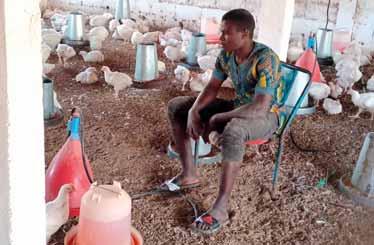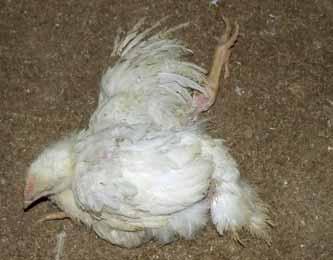
4 minute read
Using the signals
LOOK-THINK-ACT
Using the signals
Advertisement
Use what you see to improve your flock management. A genuine signal will be repeated. Think about what you are seeing and how it relates to the circumstances: does it happen often, at different times, to different birds, on other farms? Go and see for yourself or ask people. Know when risks are likely to occur and keep one step ahead by eliminating them or being extra alert if you are expecting them.
Vulnerable birds
There will always be some vulnerable birds in a flock, such as poorly developed ones. They will be the first to suffer from disease, lack of water or other shortcomings. These are also the signal birds: the first ones to tell you that something is wrong; all the more reason to be aware of them. Think about which birds and problems these are, in terms of your particular farm and how you can respond to them promptly. Some birds will also pose a risk to others, e.g. as a source of infection. What should you do with this bird? This is a high risk bird. It is not able to get to feed and water and will die anyway. But other birds may peck at it or in a hot climate it will start decaying fast, leading to further problems. Take it out directly and cull it. Signs humans can’t see copyright protected Aids such as an infrared camera show what the human eye can’t see. The roof of this house during a cold night has not been properly insulated: the ridge is about 10°C colder than the rest of the roof. Result: it cools down and condensation forms, possibly dripping on the floor. Wet litter is a cause of many health problems.
If you see anything that draws your attention: take a closer look.

Farm blindness
You can only recognise an irregularity if you know what is normal. You will learn what is normal by observing as often and as objectively as possible. But be aware of the dangers of farm blindness. Farm blindness is when you see the situation on your own farm as the norm. Limit farm blindness by talking to colleagues and advisors. Act on critical comments. Also go and look at other poultry keepers’ operations (but always comply with biosecurity rules).
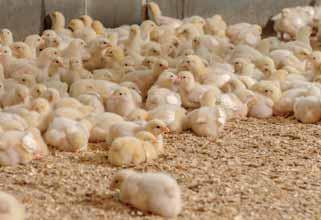
LOOK-THINK-ACT
How to observe your birds in a structured way:
1. Look at them both with and without doing other things. 2. Look at the whole flock, the individual chicken and then back to the flock. 3. Look for averages and extremes. 4. Look at the front, back and middle of the house. The same applies to processes such as feeding. Look at the front, middle and back of the feeding system that is being filled. What is happening there? 5. Look at different times and in different circumstances. 6. At regular intervals, stand still in the broiler house and also get down and move about at the level the birds live at. 7. Identify critical times, susceptible birds and danger zones and keep an extra eye on them. What do these chicks tell you? The chicks are creeping up to the wall and pecking at it. This is often a sign of anxiety or stress. Broilers are flight animals and seek protection when there is an unexpected visit. If the birds are pecking calmly at the wall, this may be an indication of a problem with the feed. copyright protected
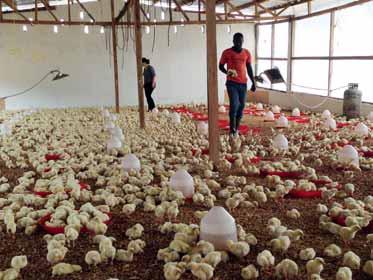
Limit farm blindness by talking to colleagues and advisors.
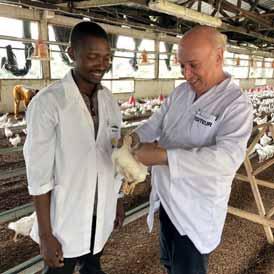
When you walk through the house, look at the birds that don’t run away quickly from under your feet. These are signal birds that can tell you things. The birds that run away first are the stronger birds. The track you leave behind you will close again. Whether this happens fast, slowly or not at all is also a signal of the birds’ vitality.
Before you start
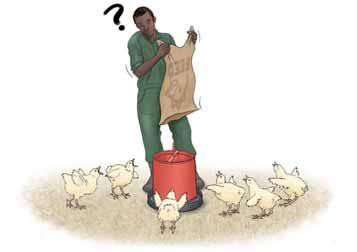
Before you start raising broilers you have to make some important decisions and make sure you meet all requirements. Do you have an adequate poultry house? What is your choice of breed? The most important is, however, do you have a sufficient amount of feed to raise the broilers up to slaughter weight and is this of sufficient quality. And is your water supply of good quality and quantity? Planning Planning is key. If you buy day-old chicks you already know how much feed you need, how much copyright protected water you need, how much space you need and how you are going to market the final product. If one of these factors is not covered yet, don’t start!
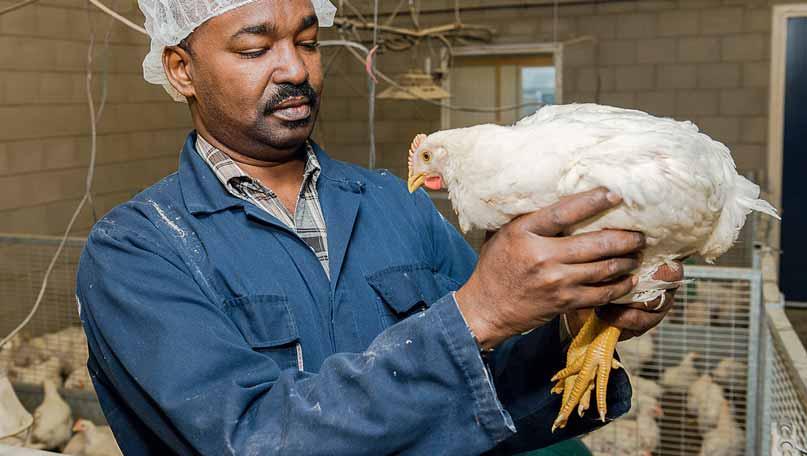
It is not uncommon that a broiler farmer finds out he hasn’t got sufficient feed stuff to raise the broilers up to market weight. Often a cheap or inferior feed is than used to cover the gap, but the birds will just stop growing or develop all kind of problems.
Things to do before you start
• Make a planning from day-old chick to market • Decide which breed to use • Have a proper farm recording in place • Ensure that you have sufficient quality feed and water


